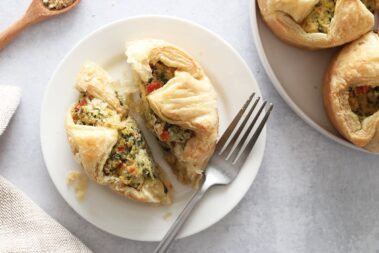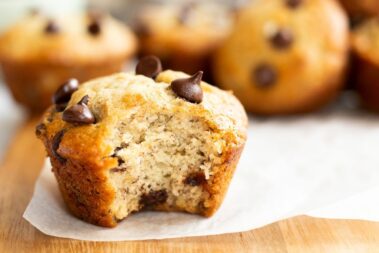French toast is an absolute classic when it comes to delicious and nourishing breakfast. The best part about it? It can be cooked and served in many different ways, ensuring that every member of your household is happy.
Utilizing key ingredients like bread, eggs and milk, you can adapt the flavor to your liking, include your favorite toppings, or modify this breakfast item to accommodate allergies and other dietary requirements.
Additionally, these hearty French toast sticks are easy to eat, kid-friendly, and an excellent way to avoid wasting stale bread.

Table of Contents
What is French Toast?
French toast, also known in some countries as “eggy bread,” is a popular breakfast dish made from slices of bread soaked in a mixture of beaten eggs, milk, and often flavored with ingredients like vanilla, cinnamon, and sugar.
The soaked bread is then pan-fried until golden brown and slightly crispy. Modern versions of this recipe may also include other cooking methods, such as oven baking or air frying.
Although it’s commonly known as French toast, its origins may date as far back as the Roman Empire. The Romans had a dish called pan dulcis, which involved soaking bread in a mixture of milk and eggs, and then frying it in order to salvage stale bread.
The modern name is believed to come from 17th century England to reference the French dish pain perdu, which directly translates to “lost bread,” reflecting its use for repurposing stale loaves.
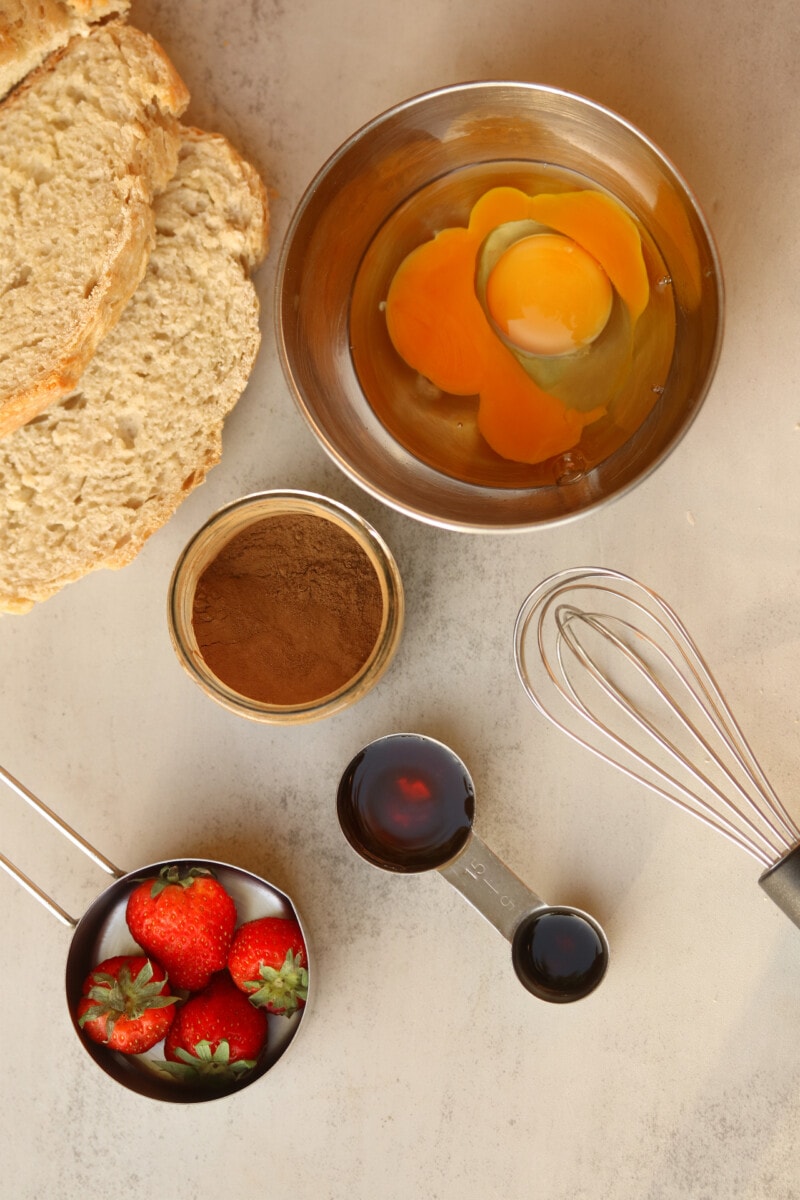

Key Ingredients
Naturally, the best French toast sticks have to include a few staple ingredients before you branch out and add various flavors and toppings:
- Bread. Traditionally, French toast was a way to utilize stale bread. You transform anything from sandwich bread and fresh sourdough to an old bagel or a burger bun into delicious breakfast.
- Eggs. In order to give it a new life, the bread is coated in an egg mixture and fried. Using high-quality eggs is advised for the best results.
- Milk. Whether you use dairy or a plant-based alternative, adding milk into the egg mixture helps the flavors soak into the bread.
- Sugar. If you’re making a sweet French toast breakfast, it’s imperative that you add a sweetener, such as sugar or maple syrup.
- Oil or butter. To stop them from getting stuck to the pan, as well as ensure the beautiful crispy edges, the French toast sticks are fried with oil or melted butter.
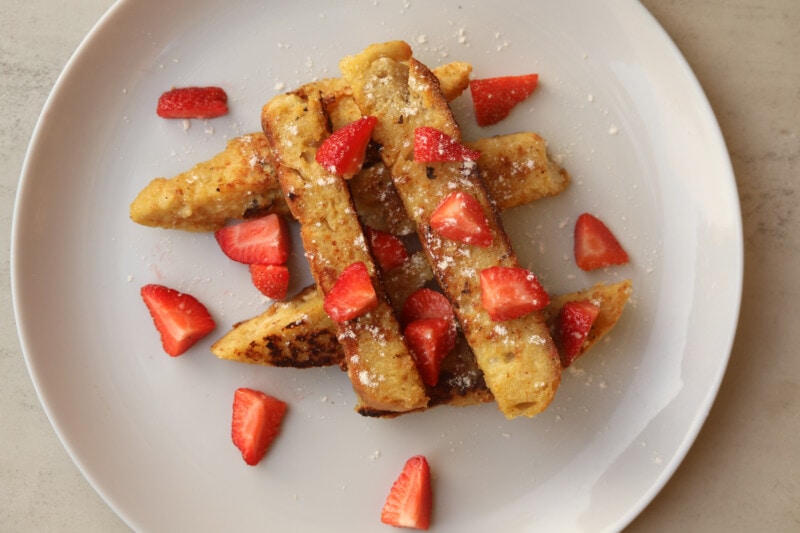
French Toast Around the World
Historically, variations of this dish have appeared in cultures around the world, each with its own unique preparation and flavors.
- Torrijas are a traditional Spanish dessert, often consumed during Easter. They are typically flavored with cinnamon and sometimes served with honey.
- In Italy, stale bread is often used to make a savory dish called frittata di pane. Bread is soaked in a mixture of eggs, cheese, and herbs, then cooked until golden and set.
- Bombay toast is a popular street food in India. Bread slices are dipped in a spiced egg mixture and then pan-fried until crispy. It’s typically served with chutneys or ketchup.
- In Scotland, French toast is typically served as a savory dish known as eggy bread. It’s a simple and hearty breakfast dish popular among the working class.
- Rabanadas are a Portuguese version of French toast, commonly enjoyed during Christmas. Bread slices are fried in a mixture of milk, eggs, and port wine, and served dusted with sugar and cinnamon.
How to Make the Best French Toast Sticks
This recipe easily transforms stale bread into a sweet or savory breakfast treat. It’s oh-so-easy, super-affordable, and ready in 15 minutes! Follow these steps to make the best French toast sticks:
1. Start by prepping your ingredients and kitchenware.
2. Cut the bread into thick “sticks” about 1 inch in width. Depending on the type of bread you are using, your French toast sticks may vary in uniformity, which would only add to their charm.

3. Crack the eggs into a bowl wide enough to fit the length of your bread slices. First, combine the eggs with a whisk, then add milk, salt, and sweet flavorings if applicable.

4. Heat the oil in a frying pan. Using kitchen tongs, carefully dip each piece of bread into the egg mixture and add it to the pan. Leave some space between the French toast sticks. Turn the bread until each of the sides is golden and crispy.

5. Serve immediately, topped with fresh fruit, powdered sugar, and maple syrup. For a savory version, consider adding some Parmesan, fresh herbs, or a dip.

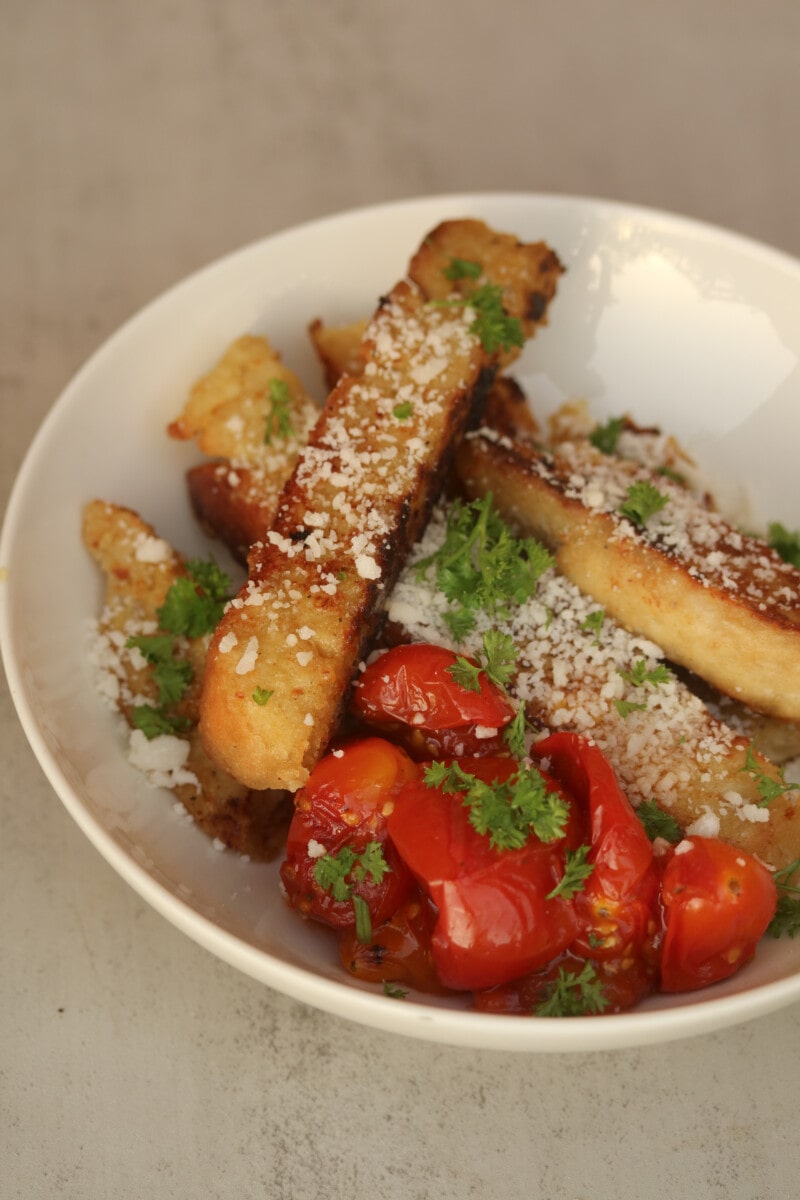
Recipe Tips and Substitutions
- Experiment with the toppings! Swap or add toppings such as berries, syrup, cinnamon sugar, or even whipped cream.
- No fresh fruit? No problem! Canned and frozen fruit, as well as jams and jellies make a fabulous addition to the best French toast sticks.
- Adjust the seasoning. You can use the first couple of French toast sticks as “test subjects” to figure out if the egg mixture needs adjusting before you fry the full batch of bread.
- Try it with different eggs. You’d be surprised how much difference it makes. As well as regular chicken eggs, this recipe works with guinea fowl eggs, duck eggs, or silkie eggs.
- Dairy-free. Substitute any unsweetened plant-based milk alternative for cow’s milk for a dairy-free version of these French toast sticks.
- Egg-free. If you’re avoiding eggs for any reason, you have two wonderful options to replace eggs in this recipe. You can either whisk 3/4 cup of aquafaba and forego the milk, or whisk a heaped tablespoon of chickpea flour with half a cup of water and the rest of the ingredients as listed.
- Gluten-free. Would this work with gluten-free bread? Sure! However, gluten-free bread tends to be more fragile, so you may keep the slices larger to stop them from crumbling.

Frequently Asked Questions
Are French toast sticks healthy?
At its heart, this recipe is healthier than the traditional recipes that use refined sugar and butter. It strikes a great balance of essential nutrients, including carbs, protein, fiber, and natural sugars.
The ingredient list is made up entirely of whole-food ingredients, which can also be adapted to your dietary requirements and preference.
Can French toast sticks be cooked in an air fryer?
Absolutely! Actually, making this dish in an air fryer makes these French toast sticks even healthier, as it does not require any oil or butter.
To use this cooking method, preheat the air fryer to 375 F. If your air fryer does not have a preheat setting, simply run it at the desired temperature for 3-5 minutes.
Line the air fryer tray with parchment paper and lay out the bread dipped in the egg mixture. You’ll have to work quite quickly but on the upside, you won’t have to keep turning your French toast sticks!
Bake your French toast for about 5-6 minutes for a crispy golden exterior and a soft, chewy center.
What kind of bread is best for French toast sticks?
As intended, the bread that works best for this recipe should be slightly stale. It should be easy enough to cut yet firmer than a fresh loaf.
Does that mean you have to wait for your bread to go stale to enjoy the best French toast sticks? Not at all! If you’re using fresh bread, simply toast it slightly before dipping it in egg mixture.
As for the type of bread, it can be virtually anything, from a supermaket sandwich loaf to artisanal sourdough. Even baked goods like bagels and croissants can be transformed into delicious French toast!
Is egg bread the same as French toast?
Technically, yes. Both refer to bread dipped into a mixture of eggs whisked with milk and seasonings and cooked until golden.
However, in certain regions, these terms are used separately to denote a sweet breakfast dish (French toast) and a savory meal (egg bread or eggy bread).
Serving Suggestions
- Tempeh Bacon. Pair this recipe with the vegan version of everyone’s favorite breakfast staple.
- Ice cream. Balance the warm cinnamon flavor with a scoop of your favorite ice treat.
- Hummus. Dip your savory French toast sticks in hummus to balance the crunch with the creamy texture of the chickpea dip.

The Best French Toast Sticks
Ingredients
Sweet French Toast Sticks
- 1 tsp cinnamon
- 4 tbsp maple syrup plus more to serve
- 1 tsp vanilla extract
- 1 cup strawberries quartered
- powdered sugar to serve
Savory French Toast Sticks
- Parmesan to serve
- Fresh parsley to serve
- Dip or sauce
Instructions
- Start by cutting the bread into 1-inch pieces. Set aside.
- In a shallow bowl, whisk together the eggs. If making sweet French toast, gently whisk in the milk, maple syrup, vanilla, cinnamon, and a tiny bit of salt. For a savory option, whisk in the milk and salt.
- Drizzle the oil in a frying pan and allow it to heat over medium heat. Using the kitchen tongs, dip each "stick" into the egg mixture, making sure the outside is coated. Immediately transfer the toast into the frying pan, leaving a slight gap in between them. Fry until golden on each side, turning the French toast sticks every couple of minutes.
- Repeat until all of the bread and egg mixture is used up.
- Serve hot with toppings of choice (powdered sugar, berries and maple syrup, or Parmesan and dip for savory French toast).
Notes
- Experiment with the toppings! Swap or add toppings such as berries, syrup, cinnamon sugar, or even whipped cream.
- No fresh fruit? No problem! Canned and frozen fruit, as well as jams and jellies make a fabulous addition to the best French toast sticks.
- Adjust the seasoning. You can use the first couple of French toast sticks as “test subjects” to figure out if the egg mixture needs adjusting before you fry the full batch of bread.
- Try it with different eggs. You’d be surprised how much difference it makes. As well as regular chicken eggs, this recipe works with guinea fowl eggs, duck eggs, or silkie eggs.
- Dairy-free. Substitute any unsweetened plant-based milk alternative for cow’s milk for a dairy-free version of these French toast sticks.
- Egg-free. If you’re avoiding eggs for any reason, you have two wonderful options to replace eggs in this recipe. You can either whisk 3/4 cup of aquafaba and forego the milk, or whisk a heaped tablespoon of chickpea flour with half a cup of water and the rest of the ingredients as listed.
- Gluten-free. Would this work with gluten-free bread? Sure! However, gluten-free bread tends to be more fragile, so you may keep the slices larger to stop them from crumbling.
Recommended Tools & Products
Nutrition

About the Author
Cat is a content creator with many outlets. In addition to writing and translation work, she’s a yoga teacher, recipe creator, and food photographer with a keen interest in wellness and sustainability. Originally from a small town in Lithuania, she spent 11 years living in Birmingham, UK, before moving back to her home country and settling there with her partner.
In 2016, she completed training as a yoga teacher and also became a certified rock climbing instructor, further expanding my career to include many hobbies. Her commitment to veganism and sustainability is not purely on paper either. Living on a semi-off-grid homestead in rural Lithuania, she spends time growing and preserving food and caring for rescue animals, including goats, rabbits, and farm birds. In her free time, she loves to craft using textiles and yarn, read, and run local trails. Not that this type of lifestyle affords a lot of free time! That said, being able to share my various experiences through writing and photography is essentially a dream job, because it allows me to do what I love and expand my horizons even further.
- Vegan Breakfast Hash - November 17, 2022
- 28 Best Vegan Mushroom Recipes - November 15, 2022

